Solar Projects in East Timor
VerifiedAdded on 2022/11/29
|16
|3667
|182
AI Summary
This document provides a planning and execution plan for solar projects in East Timor. It discusses the business objectives, project objectives, project scope, project cost, success criteria, issues faced, and key performance indicators. The document also includes a risk management plan.
Contribute Materials
Your contribution can guide someone’s learning journey. Share your
documents today.
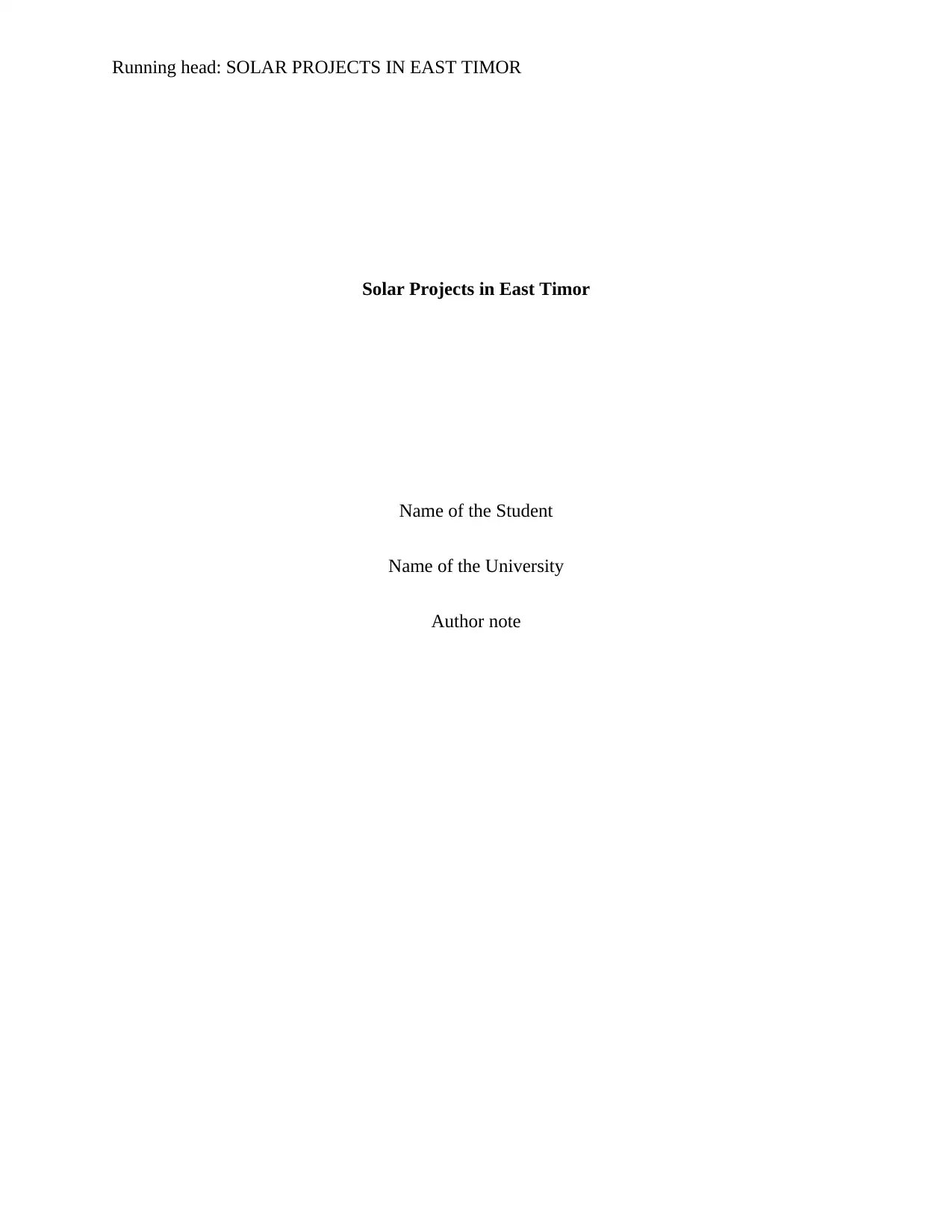
Running head: SOLAR PROJECTS IN EAST TIMOR
Solar Projects in East Timor
Name of the Student
Name of the University
Author note
Solar Projects in East Timor
Name of the Student
Name of the University
Author note
Secure Best Marks with AI Grader
Need help grading? Try our AI Grader for instant feedback on your assignments.
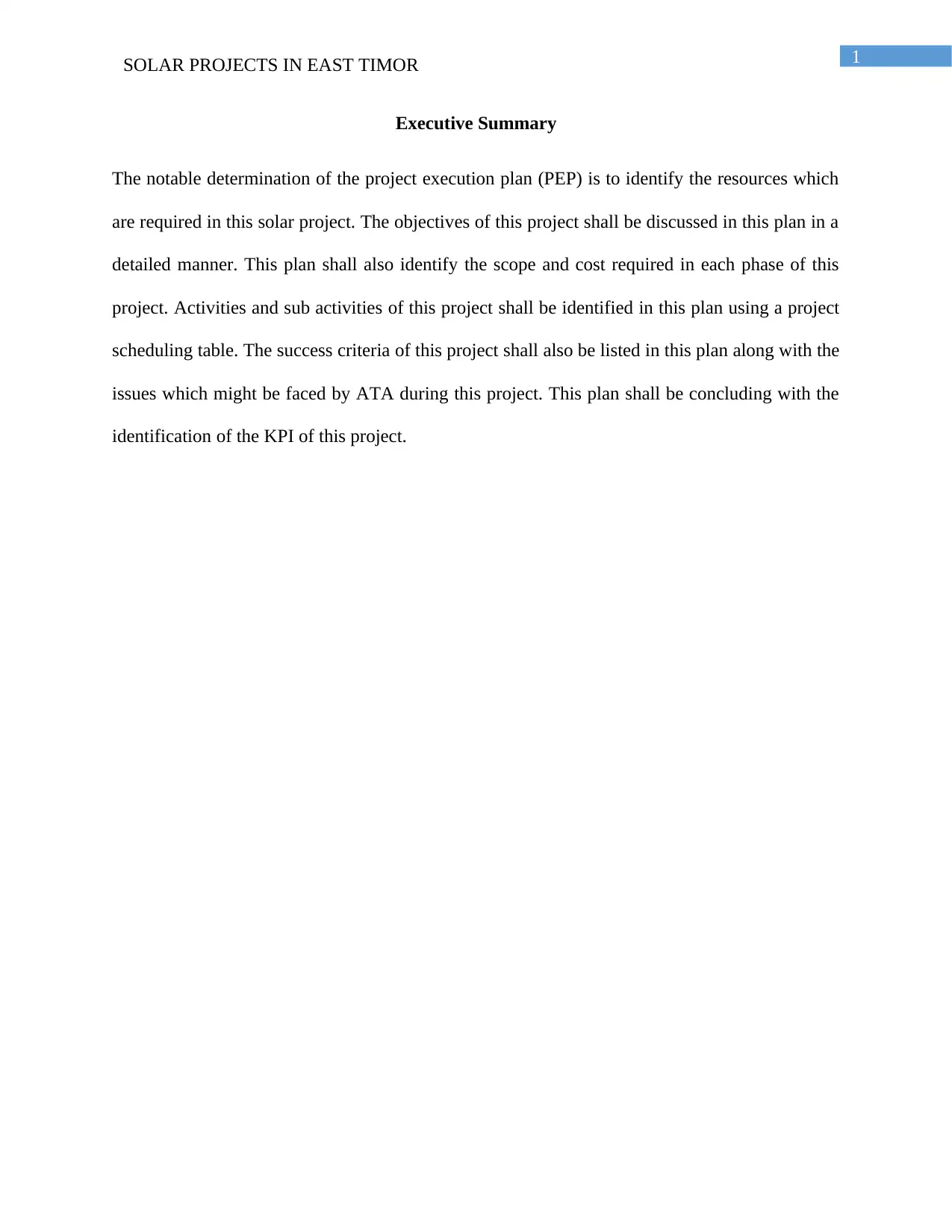
1SOLAR PROJECTS IN EAST TIMOR
Executive Summary
The notable determination of the project execution plan (PEP) is to identify the resources which
are required in this solar project. The objectives of this project shall be discussed in this plan in a
detailed manner. This plan shall also identify the scope and cost required in each phase of this
project. Activities and sub activities of this project shall be identified in this plan using a project
scheduling table. The success criteria of this project shall also be listed in this plan along with the
issues which might be faced by ATA during this project. This plan shall be concluding with the
identification of the KPI of this project.
Executive Summary
The notable determination of the project execution plan (PEP) is to identify the resources which
are required in this solar project. The objectives of this project shall be discussed in this plan in a
detailed manner. This plan shall also identify the scope and cost required in each phase of this
project. Activities and sub activities of this project shall be identified in this plan using a project
scheduling table. The success criteria of this project shall also be listed in this plan along with the
issues which might be faced by ATA during this project. This plan shall be concluding with the
identification of the KPI of this project.
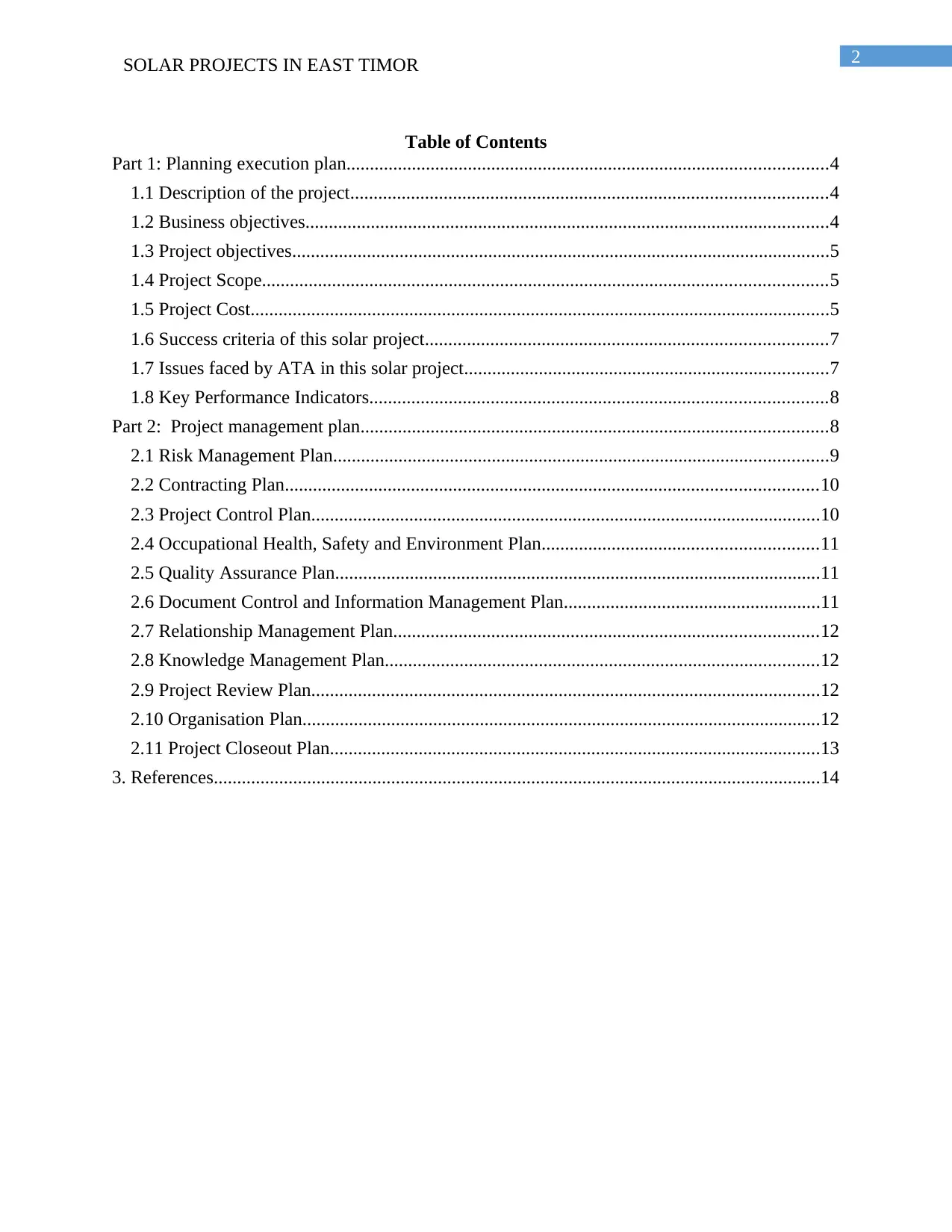
2SOLAR PROJECTS IN EAST TIMOR
Table of Contents
Part 1: Planning execution plan.......................................................................................................4
1.1 Description of the project......................................................................................................4
1.2 Business objectives................................................................................................................4
1.3 Project objectives...................................................................................................................5
1.4 Project Scope.........................................................................................................................5
1.5 Project Cost............................................................................................................................5
1.6 Success criteria of this solar project......................................................................................7
1.7 Issues faced by ATA in this solar project..............................................................................7
1.8 Key Performance Indicators..................................................................................................8
Part 2: Project management plan....................................................................................................8
2.1 Risk Management Plan..........................................................................................................9
2.2 Contracting Plan..................................................................................................................10
2.3 Project Control Plan.............................................................................................................10
2.4 Occupational Health, Safety and Environment Plan...........................................................11
2.5 Quality Assurance Plan........................................................................................................11
2.6 Document Control and Information Management Plan.......................................................11
2.7 Relationship Management Plan...........................................................................................12
2.8 Knowledge Management Plan.............................................................................................12
2.9 Project Review Plan.............................................................................................................12
2.10 Organisation Plan...............................................................................................................12
2.11 Project Closeout Plan.........................................................................................................13
3. References..................................................................................................................................14
Table of Contents
Part 1: Planning execution plan.......................................................................................................4
1.1 Description of the project......................................................................................................4
1.2 Business objectives................................................................................................................4
1.3 Project objectives...................................................................................................................5
1.4 Project Scope.........................................................................................................................5
1.5 Project Cost............................................................................................................................5
1.6 Success criteria of this solar project......................................................................................7
1.7 Issues faced by ATA in this solar project..............................................................................7
1.8 Key Performance Indicators..................................................................................................8
Part 2: Project management plan....................................................................................................8
2.1 Risk Management Plan..........................................................................................................9
2.2 Contracting Plan..................................................................................................................10
2.3 Project Control Plan.............................................................................................................10
2.4 Occupational Health, Safety and Environment Plan...........................................................11
2.5 Quality Assurance Plan........................................................................................................11
2.6 Document Control and Information Management Plan.......................................................11
2.7 Relationship Management Plan...........................................................................................12
2.8 Knowledge Management Plan.............................................................................................12
2.9 Project Review Plan.............................................................................................................12
2.10 Organisation Plan...............................................................................................................12
2.11 Project Closeout Plan.........................................................................................................13
3. References..................................................................................................................................14
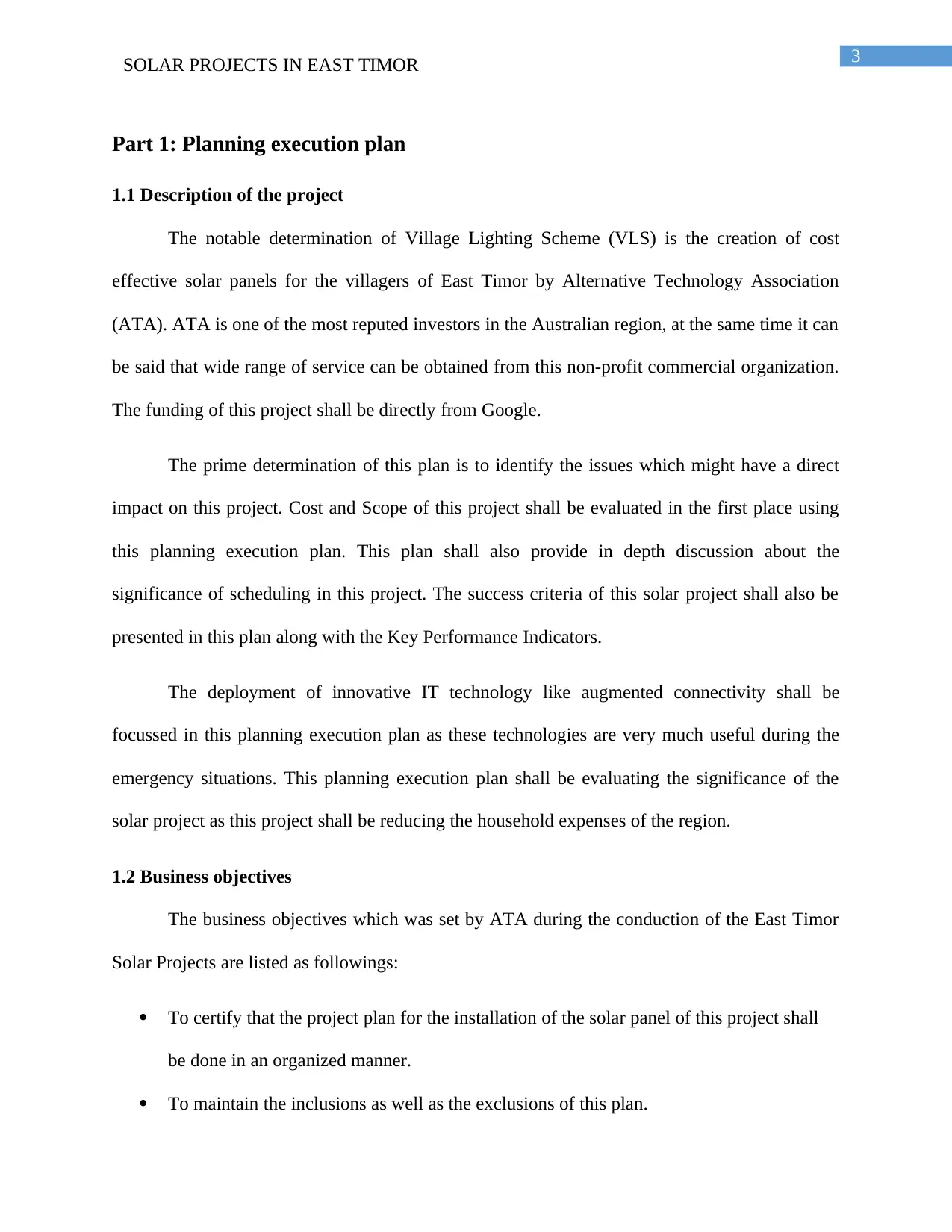
3SOLAR PROJECTS IN EAST TIMOR
Part 1: Planning execution plan
1.1 Description of the project
The notable determination of Village Lighting Scheme (VLS) is the creation of cost
effective solar panels for the villagers of East Timor by Alternative Technology Association
(ATA). ATA is one of the most reputed investors in the Australian region, at the same time it can
be said that wide range of service can be obtained from this non-profit commercial organization.
The funding of this project shall be directly from Google.
The prime determination of this plan is to identify the issues which might have a direct
impact on this project. Cost and Scope of this project shall be evaluated in the first place using
this planning execution plan. This plan shall also provide in depth discussion about the
significance of scheduling in this project. The success criteria of this solar project shall also be
presented in this plan along with the Key Performance Indicators.
The deployment of innovative IT technology like augmented connectivity shall be
focussed in this planning execution plan as these technologies are very much useful during the
emergency situations. This planning execution plan shall be evaluating the significance of the
solar project as this project shall be reducing the household expenses of the region.
1.2 Business objectives
The business objectives which was set by ATA during the conduction of the East Timor
Solar Projects are listed as followings:
To certify that the project plan for the installation of the solar panel of this project shall
be done in an organized manner.
To maintain the inclusions as well as the exclusions of this plan.
Part 1: Planning execution plan
1.1 Description of the project
The notable determination of Village Lighting Scheme (VLS) is the creation of cost
effective solar panels for the villagers of East Timor by Alternative Technology Association
(ATA). ATA is one of the most reputed investors in the Australian region, at the same time it can
be said that wide range of service can be obtained from this non-profit commercial organization.
The funding of this project shall be directly from Google.
The prime determination of this plan is to identify the issues which might have a direct
impact on this project. Cost and Scope of this project shall be evaluated in the first place using
this planning execution plan. This plan shall also provide in depth discussion about the
significance of scheduling in this project. The success criteria of this solar project shall also be
presented in this plan along with the Key Performance Indicators.
The deployment of innovative IT technology like augmented connectivity shall be
focussed in this planning execution plan as these technologies are very much useful during the
emergency situations. This planning execution plan shall be evaluating the significance of the
solar project as this project shall be reducing the household expenses of the region.
1.2 Business objectives
The business objectives which was set by ATA during the conduction of the East Timor
Solar Projects are listed as followings:
To certify that the project plan for the installation of the solar panel of this project shall
be done in an organized manner.
To maintain the inclusions as well as the exclusions of this plan.
Secure Best Marks with AI Grader
Need help grading? Try our AI Grader for instant feedback on your assignments.
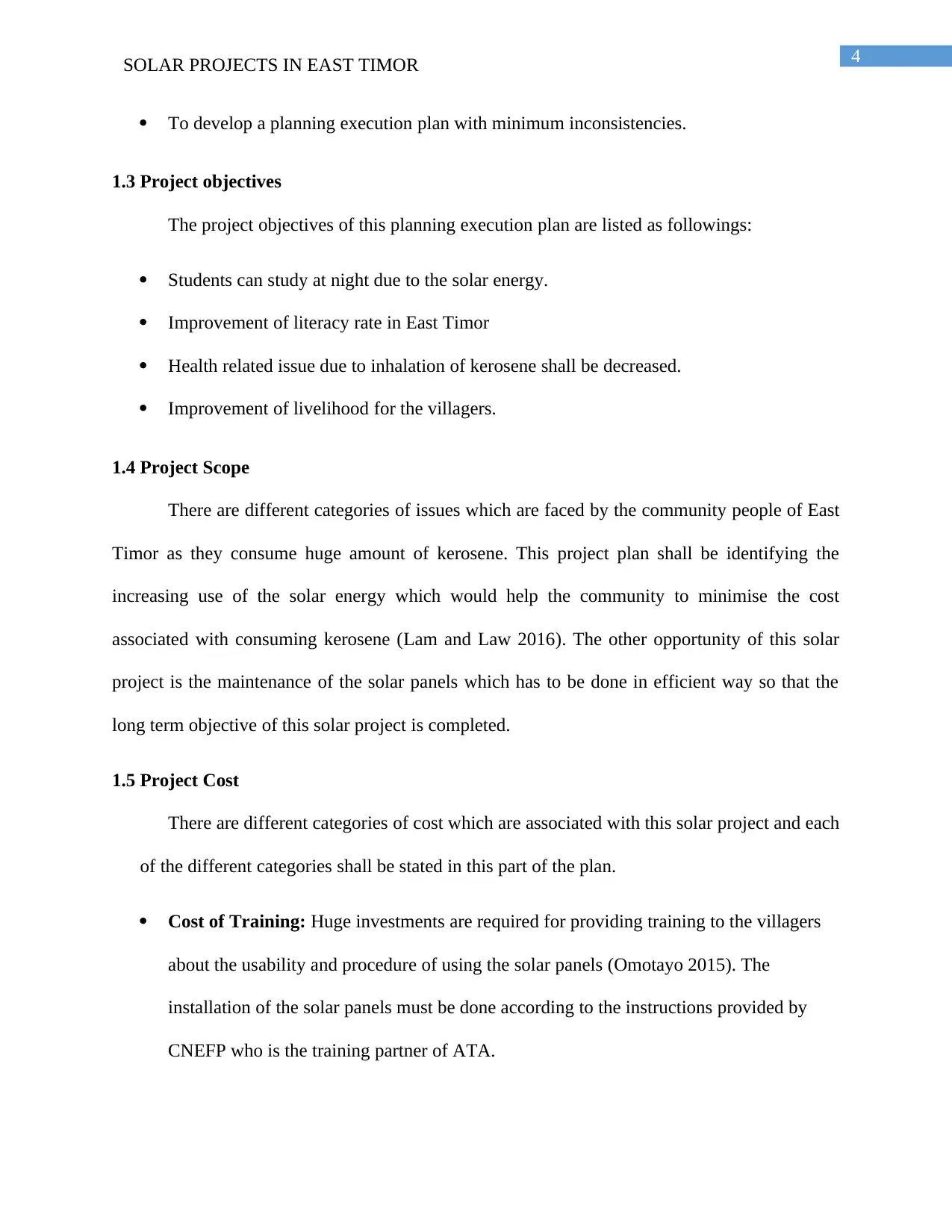
4SOLAR PROJECTS IN EAST TIMOR
To develop a planning execution plan with minimum inconsistencies.
1.3 Project objectives
The project objectives of this planning execution plan are listed as followings:
Students can study at night due to the solar energy.
Improvement of literacy rate in East Timor
Health related issue due to inhalation of kerosene shall be decreased.
Improvement of livelihood for the villagers.
1.4 Project Scope
There are different categories of issues which are faced by the community people of East
Timor as they consume huge amount of kerosene. This project plan shall be identifying the
increasing use of the solar energy which would help the community to minimise the cost
associated with consuming kerosene (Lam and Law 2016). The other opportunity of this solar
project is the maintenance of the solar panels which has to be done in efficient way so that the
long term objective of this solar project is completed.
1.5 Project Cost
There are different categories of cost which are associated with this solar project and each
of the different categories shall be stated in this part of the plan.
Cost of Training: Huge investments are required for providing training to the villagers
about the usability and procedure of using the solar panels (Omotayo 2015). The
installation of the solar panels must be done according to the instructions provided by
CNEFP who is the training partner of ATA.
To develop a planning execution plan with minimum inconsistencies.
1.3 Project objectives
The project objectives of this planning execution plan are listed as followings:
Students can study at night due to the solar energy.
Improvement of literacy rate in East Timor
Health related issue due to inhalation of kerosene shall be decreased.
Improvement of livelihood for the villagers.
1.4 Project Scope
There are different categories of issues which are faced by the community people of East
Timor as they consume huge amount of kerosene. This project plan shall be identifying the
increasing use of the solar energy which would help the community to minimise the cost
associated with consuming kerosene (Lam and Law 2016). The other opportunity of this solar
project is the maintenance of the solar panels which has to be done in efficient way so that the
long term objective of this solar project is completed.
1.5 Project Cost
There are different categories of cost which are associated with this solar project and each
of the different categories shall be stated in this part of the plan.
Cost of Training: Huge investments are required for providing training to the villagers
about the usability and procedure of using the solar panels (Omotayo 2015). The
installation of the solar panels must be done according to the instructions provided by
CNEFP who is the training partner of ATA.
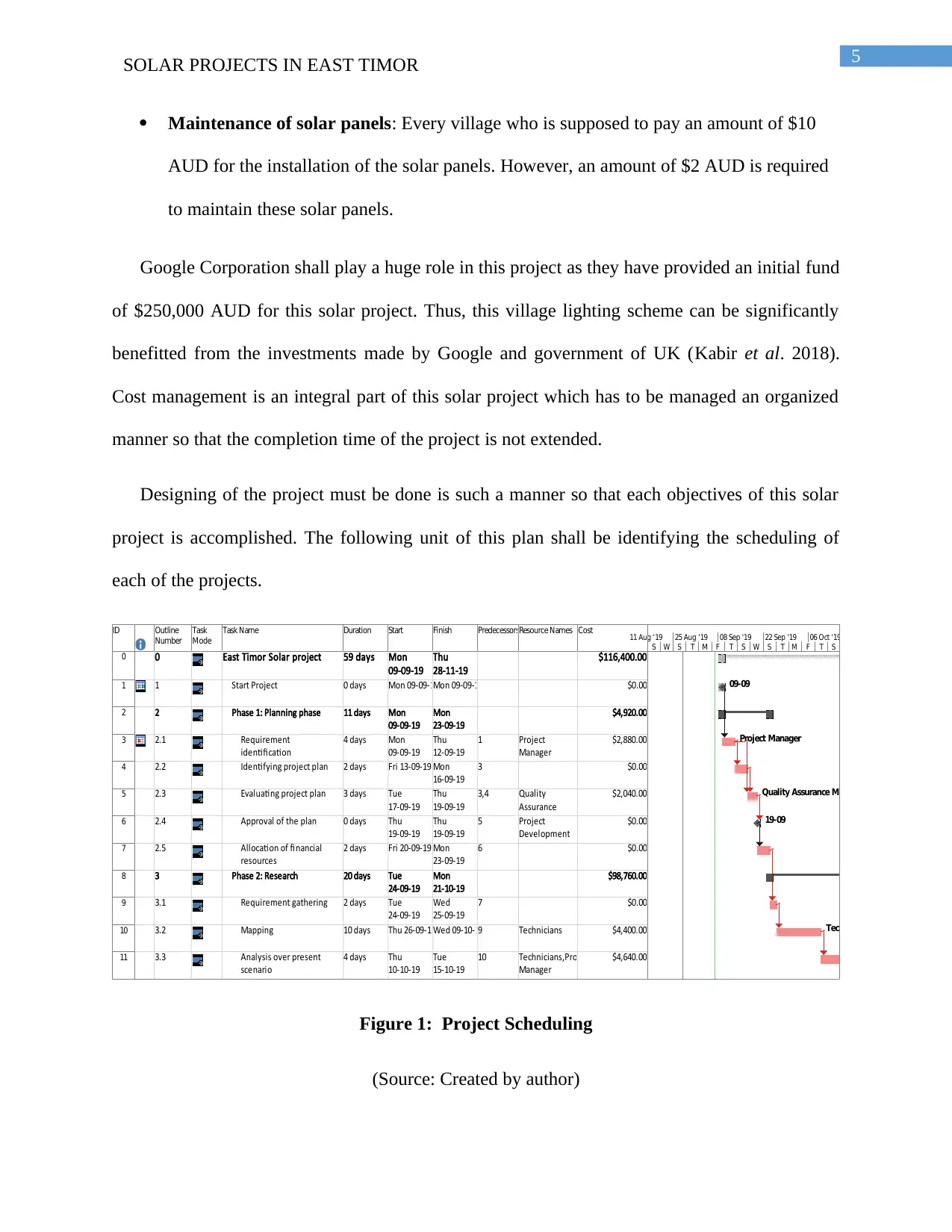
5SOLAR PROJECTS IN EAST TIMOR
Maintenance of solar panels: Every village who is supposed to pay an amount of $10
AUD for the installation of the solar panels. However, an amount of $2 AUD is required
to maintain these solar panels.
Google Corporation shall play a huge role in this project as they have provided an initial fund
of $250,000 AUD for this solar project. Thus, this village lighting scheme can be significantly
benefitted from the investments made by Google and government of UK (Kabir et al. 2018).
Cost management is an integral part of this solar project which has to be managed an organized
manner so that the completion time of the project is not extended.
Designing of the project must be done is such a manner so that each objectives of this solar
project is accomplished. The following unit of this plan shall be identifying the scheduling of
each of the projects.
ID Outline
Number
Task
Mode
Task Name Duration Start Finish PredecessorsResource Names Cost
0 0 East Timor Solar project 59 days Mon
09-09-19
Thu
28-11-19
$116,400.00
1 1 Start Project 0 days Mon 09-09-19Mon 09-09-19 $0.00
2 2 Phase 1: Planning phase 11 days Mon
09-09-19
Mon
23-09-19
$4,920.00
3 2.1 Requirement
identification
4 days Mon
09-09-19
Thu
12-09-19
1 Project
Manager
$2,880.00
4 2.2 Identifying project plan 2 days Fri 13-09-19 Mon
16-09-19
3 $0.00
5 2.3 Evaluating project plan 3 days Tue
17-09-19
Thu
19-09-19
3,4 Quality
Assurance
Manager,Subject
$2,040.00
6 2.4 Approval of the plan 0 days Thu
19-09-19
Thu
19-09-19
5 Project
Development
Manager,Project
$0.00
7 2.5 Allocation of financial
resources
2 days Fri 20-09-19 Mon
23-09-19
6 $0.00
8 3 Phase 2: Research 20 days Tue
24-09-19
Mon
21-10-19
$98,760.00
9 3.1 Requirement gathering 2 days Tue
24-09-19
Wed
25-09-19
7 $0.00
10 3.2 Mapping 10 days Thu 26-09-19Wed 09-10-199 Technicians $4,400.00
11 3.3 Analysis over present
scenario
4 days Thu
10-10-19
Tue
15-10-19
10 Technicians,Project
Manager
$4,640.00
09-09
Project Manager
Quality Assurance Manager,Subject Matter Experts
19-09
Technicians
Technicians,Project Manager
S W S T M F T S W S T M F T S
11 Aug '19 25 Aug '19 08 Sep '19 22 Sep '19 06 Oct '19
Figure 1: Project Scheduling
(Source: Created by author)
Maintenance of solar panels: Every village who is supposed to pay an amount of $10
AUD for the installation of the solar panels. However, an amount of $2 AUD is required
to maintain these solar panels.
Google Corporation shall play a huge role in this project as they have provided an initial fund
of $250,000 AUD for this solar project. Thus, this village lighting scheme can be significantly
benefitted from the investments made by Google and government of UK (Kabir et al. 2018).
Cost management is an integral part of this solar project which has to be managed an organized
manner so that the completion time of the project is not extended.
Designing of the project must be done is such a manner so that each objectives of this solar
project is accomplished. The following unit of this plan shall be identifying the scheduling of
each of the projects.
ID Outline
Number
Task
Mode
Task Name Duration Start Finish PredecessorsResource Names Cost
0 0 East Timor Solar project 59 days Mon
09-09-19
Thu
28-11-19
$116,400.00
1 1 Start Project 0 days Mon 09-09-19Mon 09-09-19 $0.00
2 2 Phase 1: Planning phase 11 days Mon
09-09-19
Mon
23-09-19
$4,920.00
3 2.1 Requirement
identification
4 days Mon
09-09-19
Thu
12-09-19
1 Project
Manager
$2,880.00
4 2.2 Identifying project plan 2 days Fri 13-09-19 Mon
16-09-19
3 $0.00
5 2.3 Evaluating project plan 3 days Tue
17-09-19
Thu
19-09-19
3,4 Quality
Assurance
Manager,Subject
$2,040.00
6 2.4 Approval of the plan 0 days Thu
19-09-19
Thu
19-09-19
5 Project
Development
Manager,Project
$0.00
7 2.5 Allocation of financial
resources
2 days Fri 20-09-19 Mon
23-09-19
6 $0.00
8 3 Phase 2: Research 20 days Tue
24-09-19
Mon
21-10-19
$98,760.00
9 3.1 Requirement gathering 2 days Tue
24-09-19
Wed
25-09-19
7 $0.00
10 3.2 Mapping 10 days Thu 26-09-19Wed 09-10-199 Technicians $4,400.00
11 3.3 Analysis over present
scenario
4 days Thu
10-10-19
Tue
15-10-19
10 Technicians,Project
Manager
$4,640.00
09-09
Project Manager
Quality Assurance Manager,Subject Matter Experts
19-09
Technicians
Technicians,Project Manager
S W S T M F T S W S T M F T S
11 Aug '19 25 Aug '19 08 Sep '19 22 Sep '19 06 Oct '19
Figure 1: Project Scheduling
(Source: Created by author)
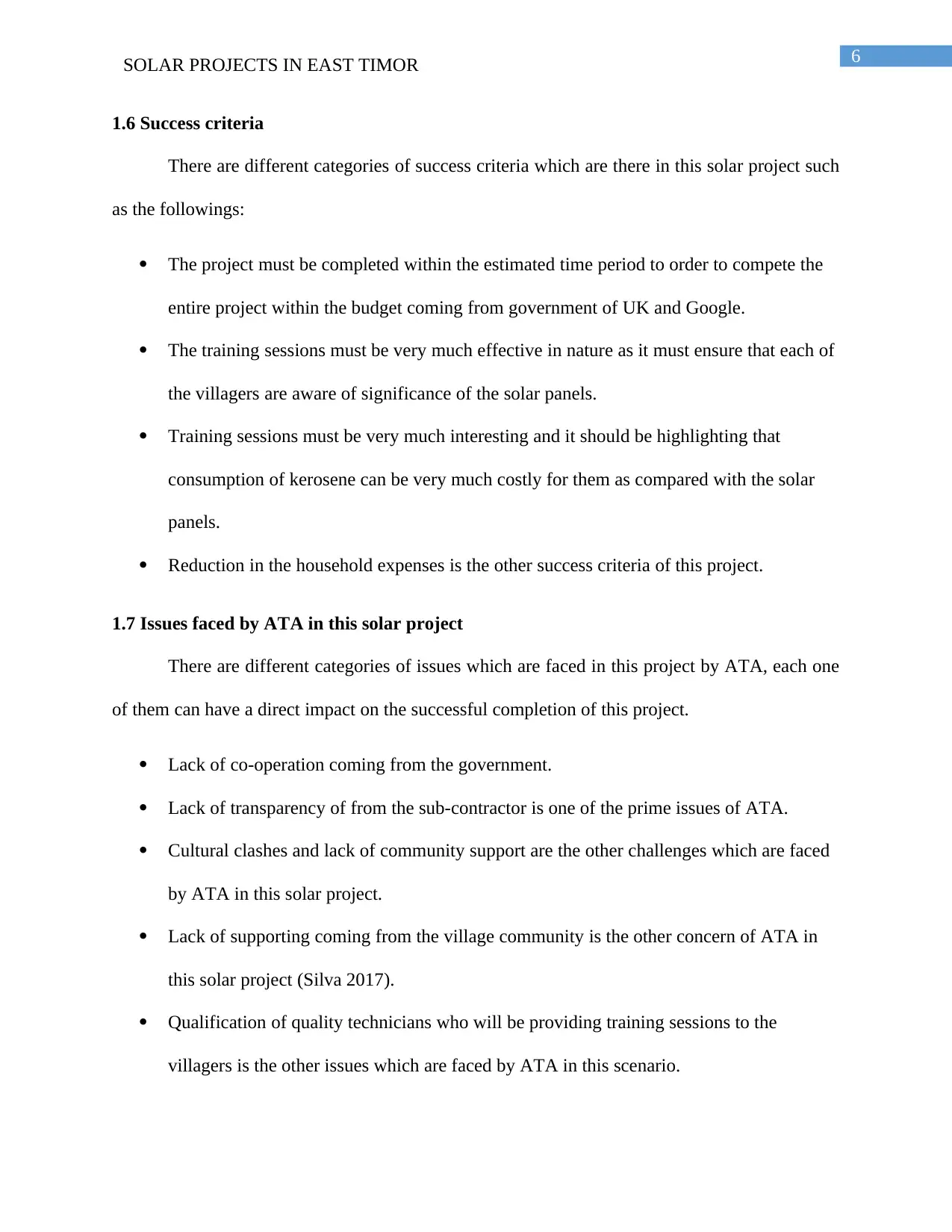
6SOLAR PROJECTS IN EAST TIMOR
1.6 Success criteria
There are different categories of success criteria which are there in this solar project such
as the followings:
The project must be completed within the estimated time period to order to compete the
entire project within the budget coming from government of UK and Google.
The training sessions must be very much effective in nature as it must ensure that each of
the villagers are aware of significance of the solar panels.
Training sessions must be very much interesting and it should be highlighting that
consumption of kerosene can be very much costly for them as compared with the solar
panels.
Reduction in the household expenses is the other success criteria of this project.
1.7 Issues faced by ATA in this solar project
There are different categories of issues which are faced in this project by ATA, each one
of them can have a direct impact on the successful completion of this project.
Lack of co-operation coming from the government.
Lack of transparency of from the sub-contractor is one of the prime issues of ATA.
Cultural clashes and lack of community support are the other challenges which are faced
by ATA in this solar project.
Lack of supporting coming from the village community is the other concern of ATA in
this solar project (Silva 2017).
Qualification of quality technicians who will be providing training sessions to the
villagers is the other issues which are faced by ATA in this scenario.
1.6 Success criteria
There are different categories of success criteria which are there in this solar project such
as the followings:
The project must be completed within the estimated time period to order to compete the
entire project within the budget coming from government of UK and Google.
The training sessions must be very much effective in nature as it must ensure that each of
the villagers are aware of significance of the solar panels.
Training sessions must be very much interesting and it should be highlighting that
consumption of kerosene can be very much costly for them as compared with the solar
panels.
Reduction in the household expenses is the other success criteria of this project.
1.7 Issues faced by ATA in this solar project
There are different categories of issues which are faced in this project by ATA, each one
of them can have a direct impact on the successful completion of this project.
Lack of co-operation coming from the government.
Lack of transparency of from the sub-contractor is one of the prime issues of ATA.
Cultural clashes and lack of community support are the other challenges which are faced
by ATA in this solar project.
Lack of supporting coming from the village community is the other concern of ATA in
this solar project (Silva 2017).
Qualification of quality technicians who will be providing training sessions to the
villagers is the other issues which are faced by ATA in this scenario.
Paraphrase This Document
Need a fresh take? Get an instant paraphrase of this document with our AI Paraphraser
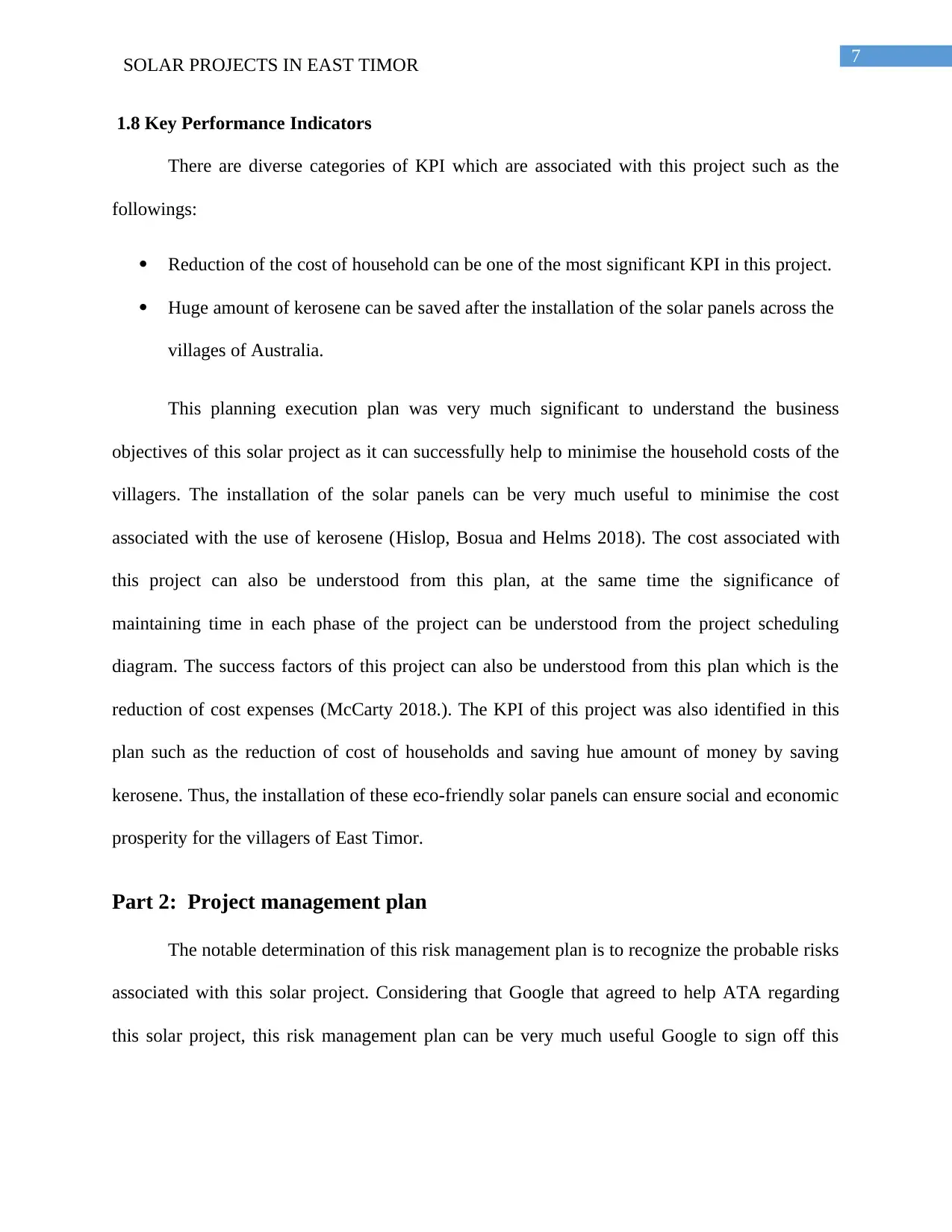
7SOLAR PROJECTS IN EAST TIMOR
1.8 Key Performance Indicators
There are diverse categories of KPI which are associated with this project such as the
followings:
Reduction of the cost of household can be one of the most significant KPI in this project.
Huge amount of kerosene can be saved after the installation of the solar panels across the
villages of Australia.
This planning execution plan was very much significant to understand the business
objectives of this solar project as it can successfully help to minimise the household costs of the
villagers. The installation of the solar panels can be very much useful to minimise the cost
associated with the use of kerosene (Hislop, Bosua and Helms 2018). The cost associated with
this project can also be understood from this plan, at the same time the significance of
maintaining time in each phase of the project can be understood from the project scheduling
diagram. The success factors of this project can also be understood from this plan which is the
reduction of cost expenses (McCarty 2018.). The KPI of this project was also identified in this
plan such as the reduction of cost of households and saving hue amount of money by saving
kerosene. Thus, the installation of these eco-friendly solar panels can ensure social and economic
prosperity for the villagers of East Timor.
Part 2: Project management plan
The notable determination of this risk management plan is to recognize the probable risks
associated with this solar project. Considering that Google that agreed to help ATA regarding
this solar project, this risk management plan can be very much useful Google to sign off this
1.8 Key Performance Indicators
There are diverse categories of KPI which are associated with this project such as the
followings:
Reduction of the cost of household can be one of the most significant KPI in this project.
Huge amount of kerosene can be saved after the installation of the solar panels across the
villages of Australia.
This planning execution plan was very much significant to understand the business
objectives of this solar project as it can successfully help to minimise the household costs of the
villagers. The installation of the solar panels can be very much useful to minimise the cost
associated with the use of kerosene (Hislop, Bosua and Helms 2018). The cost associated with
this project can also be understood from this plan, at the same time the significance of
maintaining time in each phase of the project can be understood from the project scheduling
diagram. The success factors of this project can also be understood from this plan which is the
reduction of cost expenses (McCarty 2018.). The KPI of this project was also identified in this
plan such as the reduction of cost of households and saving hue amount of money by saving
kerosene. Thus, the installation of these eco-friendly solar panels can ensure social and economic
prosperity for the villagers of East Timor.
Part 2: Project management plan
The notable determination of this risk management plan is to recognize the probable risks
associated with this solar project. Considering that Google that agreed to help ATA regarding
this solar project, this risk management plan can be very much useful Google to sign off this
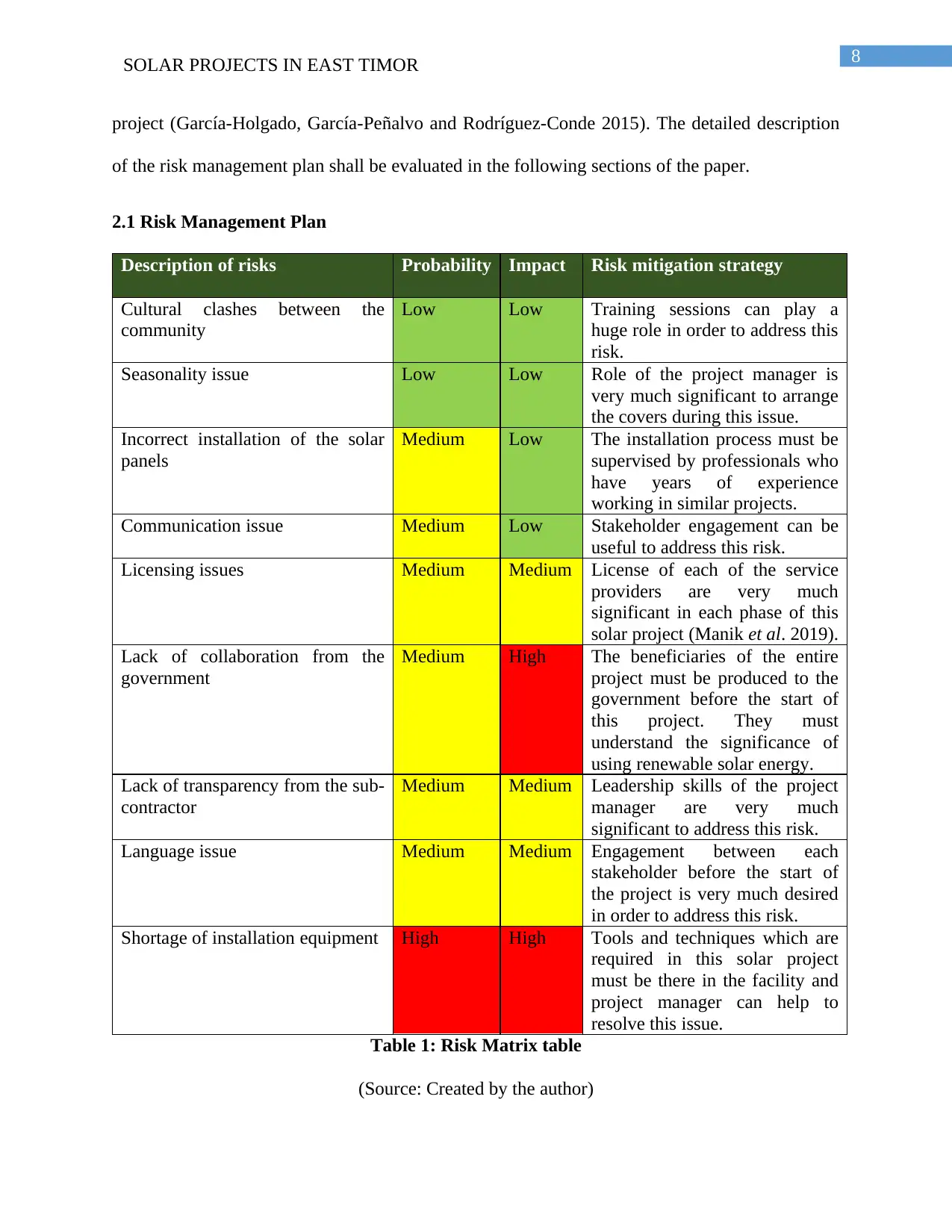
8SOLAR PROJECTS IN EAST TIMOR
project (García-Holgado, García-Peñalvo and Rodríguez-Conde 2015). The detailed description
of the risk management plan shall be evaluated in the following sections of the paper.
2.1 Risk Management Plan
Description of risks Probability Impact Risk mitigation strategy
Cultural clashes between the
community
Low Low Training sessions can play a
huge role in order to address this
risk.
Seasonality issue Low Low Role of the project manager is
very much significant to arrange
the covers during this issue.
Incorrect installation of the solar
panels
Medium Low The installation process must be
supervised by professionals who
have years of experience
working in similar projects.
Communication issue Medium Low Stakeholder engagement can be
useful to address this risk.
Licensing issues Medium Medium License of each of the service
providers are very much
significant in each phase of this
solar project (Manik et al. 2019).
Lack of collaboration from the
government
Medium High The beneficiaries of the entire
project must be produced to the
government before the start of
this project. They must
understand the significance of
using renewable solar energy.
Lack of transparency from the sub-
contractor
Medium Medium Leadership skills of the project
manager are very much
significant to address this risk.
Language issue Medium Medium Engagement between each
stakeholder before the start of
the project is very much desired
in order to address this risk.
Shortage of installation equipment High High Tools and techniques which are
required in this solar project
must be there in the facility and
project manager can help to
resolve this issue.
Table 1: Risk Matrix table
(Source: Created by the author)
project (García-Holgado, García-Peñalvo and Rodríguez-Conde 2015). The detailed description
of the risk management plan shall be evaluated in the following sections of the paper.
2.1 Risk Management Plan
Description of risks Probability Impact Risk mitigation strategy
Cultural clashes between the
community
Low Low Training sessions can play a
huge role in order to address this
risk.
Seasonality issue Low Low Role of the project manager is
very much significant to arrange
the covers during this issue.
Incorrect installation of the solar
panels
Medium Low The installation process must be
supervised by professionals who
have years of experience
working in similar projects.
Communication issue Medium Low Stakeholder engagement can be
useful to address this risk.
Licensing issues Medium Medium License of each of the service
providers are very much
significant in each phase of this
solar project (Manik et al. 2019).
Lack of collaboration from the
government
Medium High The beneficiaries of the entire
project must be produced to the
government before the start of
this project. They must
understand the significance of
using renewable solar energy.
Lack of transparency from the sub-
contractor
Medium Medium Leadership skills of the project
manager are very much
significant to address this risk.
Language issue Medium Medium Engagement between each
stakeholder before the start of
the project is very much desired
in order to address this risk.
Shortage of installation equipment High High Tools and techniques which are
required in this solar project
must be there in the facility and
project manager can help to
resolve this issue.
Table 1: Risk Matrix table
(Source: Created by the author)
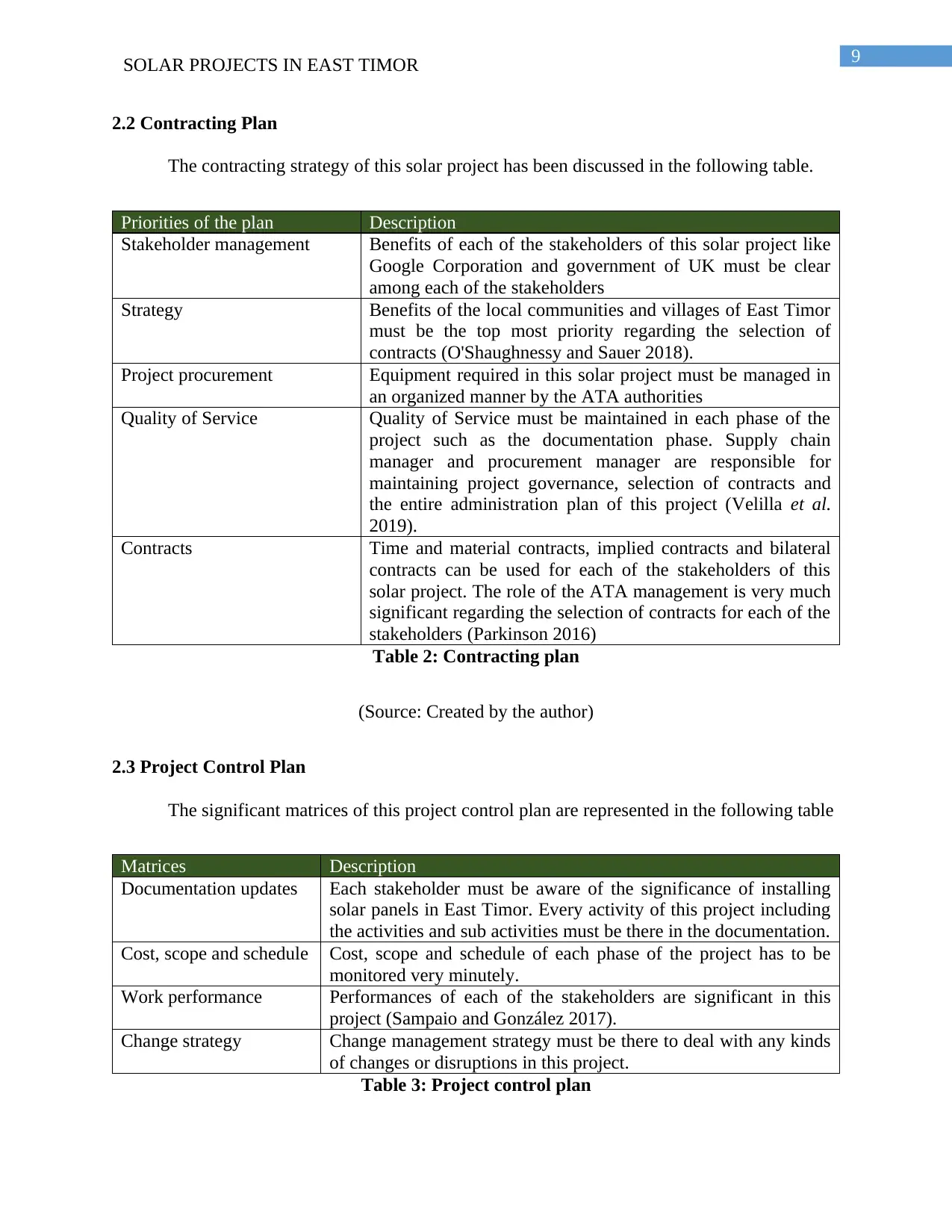
9SOLAR PROJECTS IN EAST TIMOR
2.2 Contracting Plan
The contracting strategy of this solar project has been discussed in the following table.
Priorities of the plan Description
Stakeholder management Benefits of each of the stakeholders of this solar project like
Google Corporation and government of UK must be clear
among each of the stakeholders
Strategy Benefits of the local communities and villages of East Timor
must be the top most priority regarding the selection of
contracts (O'Shaughnessy and Sauer 2018).
Project procurement Equipment required in this solar project must be managed in
an organized manner by the ATA authorities
Quality of Service Quality of Service must be maintained in each phase of the
project such as the documentation phase. Supply chain
manager and procurement manager are responsible for
maintaining project governance, selection of contracts and
the entire administration plan of this project (Velilla et al.
2019).
Contracts Time and material contracts, implied contracts and bilateral
contracts can be used for each of the stakeholders of this
solar project. The role of the ATA management is very much
significant regarding the selection of contracts for each of the
stakeholders (Parkinson 2016)
Table 2: Contracting plan
(Source: Created by the author)
2.3 Project Control Plan
The significant matrices of this project control plan are represented in the following table
Matrices Description
Documentation updates Each stakeholder must be aware of the significance of installing
solar panels in East Timor. Every activity of this project including
the activities and sub activities must be there in the documentation.
Cost, scope and schedule Cost, scope and schedule of each phase of the project has to be
monitored very minutely.
Work performance Performances of each of the stakeholders are significant in this
project (Sampaio and González 2017).
Change strategy Change management strategy must be there to deal with any kinds
of changes or disruptions in this project.
Table 3: Project control plan
2.2 Contracting Plan
The contracting strategy of this solar project has been discussed in the following table.
Priorities of the plan Description
Stakeholder management Benefits of each of the stakeholders of this solar project like
Google Corporation and government of UK must be clear
among each of the stakeholders
Strategy Benefits of the local communities and villages of East Timor
must be the top most priority regarding the selection of
contracts (O'Shaughnessy and Sauer 2018).
Project procurement Equipment required in this solar project must be managed in
an organized manner by the ATA authorities
Quality of Service Quality of Service must be maintained in each phase of the
project such as the documentation phase. Supply chain
manager and procurement manager are responsible for
maintaining project governance, selection of contracts and
the entire administration plan of this project (Velilla et al.
2019).
Contracts Time and material contracts, implied contracts and bilateral
contracts can be used for each of the stakeholders of this
solar project. The role of the ATA management is very much
significant regarding the selection of contracts for each of the
stakeholders (Parkinson 2016)
Table 2: Contracting plan
(Source: Created by the author)
2.3 Project Control Plan
The significant matrices of this project control plan are represented in the following table
Matrices Description
Documentation updates Each stakeholder must be aware of the significance of installing
solar panels in East Timor. Every activity of this project including
the activities and sub activities must be there in the documentation.
Cost, scope and schedule Cost, scope and schedule of each phase of the project has to be
monitored very minutely.
Work performance Performances of each of the stakeholders are significant in this
project (Sampaio and González 2017).
Change strategy Change management strategy must be there to deal with any kinds
of changes or disruptions in this project.
Table 3: Project control plan
Secure Best Marks with AI Grader
Need help grading? Try our AI Grader for instant feedback on your assignments.
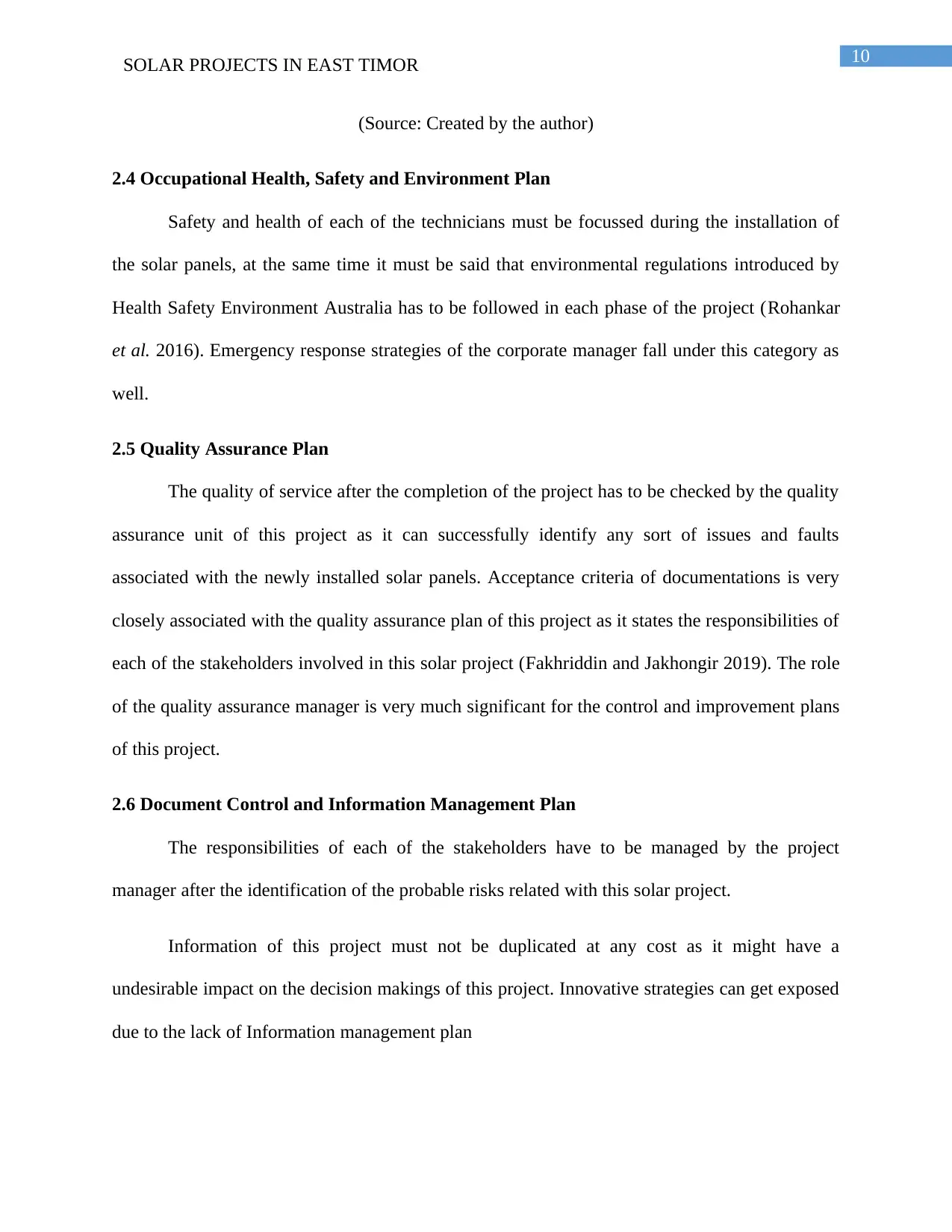
10SOLAR PROJECTS IN EAST TIMOR
(Source: Created by the author)
2.4 Occupational Health, Safety and Environment Plan
Safety and health of each of the technicians must be focussed during the installation of
the solar panels, at the same time it must be said that environmental regulations introduced by
Health Safety Environment Australia has to be followed in each phase of the project (Rohankar
et al. 2016). Emergency response strategies of the corporate manager fall under this category as
well.
2.5 Quality Assurance Plan
The quality of service after the completion of the project has to be checked by the quality
assurance unit of this project as it can successfully identify any sort of issues and faults
associated with the newly installed solar panels. Acceptance criteria of documentations is very
closely associated with the quality assurance plan of this project as it states the responsibilities of
each of the stakeholders involved in this solar project (Fakhriddin and Jakhongir 2019). The role
of the quality assurance manager is very much significant for the control and improvement plans
of this project.
2.6 Document Control and Information Management Plan
The responsibilities of each of the stakeholders have to be managed by the project
manager after the identification of the probable risks related with this solar project.
Information of this project must not be duplicated at any cost as it might have a
undesirable impact on the decision makings of this project. Innovative strategies can get exposed
due to the lack of Information management plan
(Source: Created by the author)
2.4 Occupational Health, Safety and Environment Plan
Safety and health of each of the technicians must be focussed during the installation of
the solar panels, at the same time it must be said that environmental regulations introduced by
Health Safety Environment Australia has to be followed in each phase of the project (Rohankar
et al. 2016). Emergency response strategies of the corporate manager fall under this category as
well.
2.5 Quality Assurance Plan
The quality of service after the completion of the project has to be checked by the quality
assurance unit of this project as it can successfully identify any sort of issues and faults
associated with the newly installed solar panels. Acceptance criteria of documentations is very
closely associated with the quality assurance plan of this project as it states the responsibilities of
each of the stakeholders involved in this solar project (Fakhriddin and Jakhongir 2019). The role
of the quality assurance manager is very much significant for the control and improvement plans
of this project.
2.6 Document Control and Information Management Plan
The responsibilities of each of the stakeholders have to be managed by the project
manager after the identification of the probable risks related with this solar project.
Information of this project must not be duplicated at any cost as it might have a
undesirable impact on the decision makings of this project. Innovative strategies can get exposed
due to the lack of Information management plan
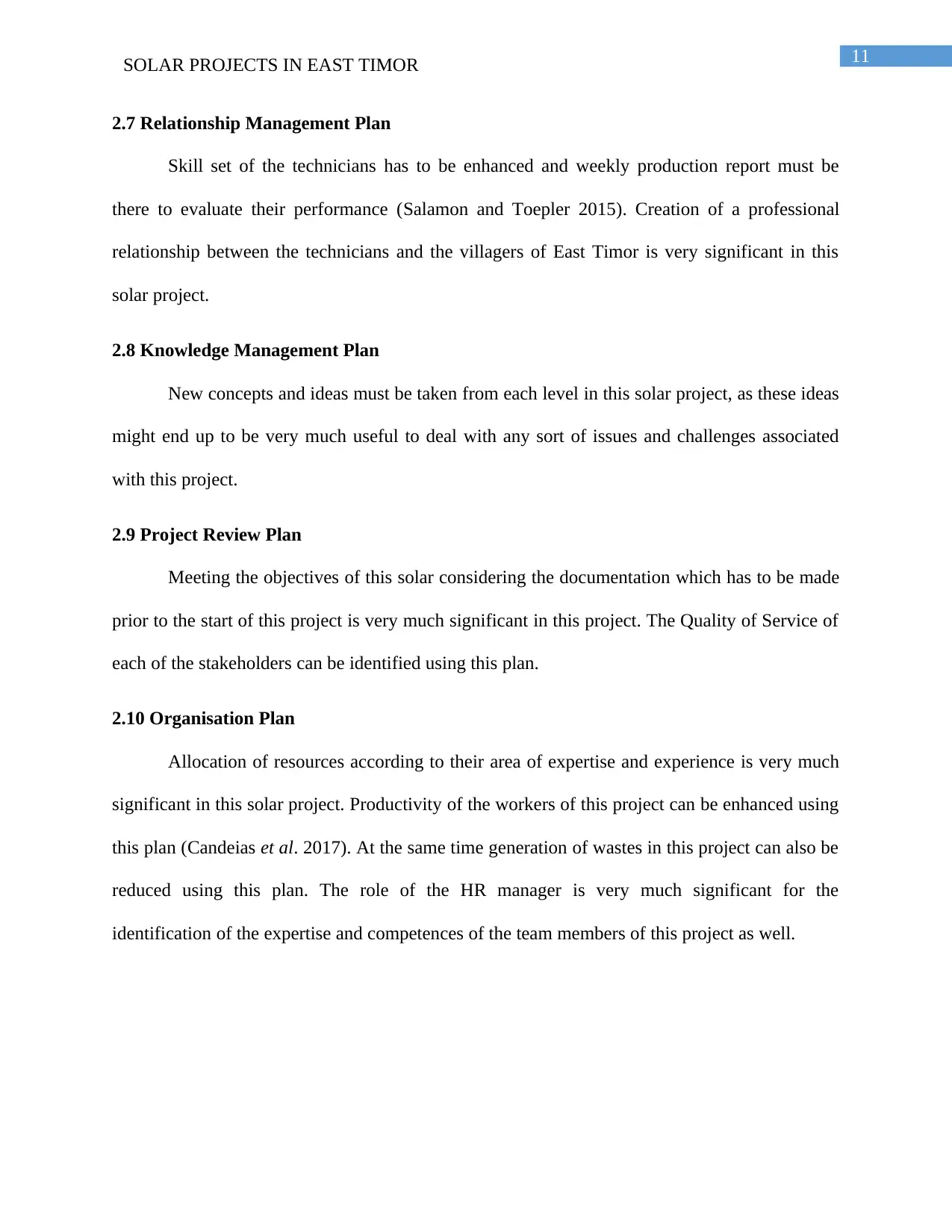
11SOLAR PROJECTS IN EAST TIMOR
2.7 Relationship Management Plan
Skill set of the technicians has to be enhanced and weekly production report must be
there to evaluate their performance (Salamon and Toepler 2015). Creation of a professional
relationship between the technicians and the villagers of East Timor is very significant in this
solar project.
2.8 Knowledge Management Plan
New concepts and ideas must be taken from each level in this solar project, as these ideas
might end up to be very much useful to deal with any sort of issues and challenges associated
with this project.
2.9 Project Review Plan
Meeting the objectives of this solar considering the documentation which has to be made
prior to the start of this project is very much significant in this project. The Quality of Service of
each of the stakeholders can be identified using this plan.
2.10 Organisation Plan
Allocation of resources according to their area of expertise and experience is very much
significant in this solar project. Productivity of the workers of this project can be enhanced using
this plan (Candeias et al. 2017). At the same time generation of wastes in this project can also be
reduced using this plan. The role of the HR manager is very much significant for the
identification of the expertise and competences of the team members of this project as well.
2.7 Relationship Management Plan
Skill set of the technicians has to be enhanced and weekly production report must be
there to evaluate their performance (Salamon and Toepler 2015). Creation of a professional
relationship between the technicians and the villagers of East Timor is very significant in this
solar project.
2.8 Knowledge Management Plan
New concepts and ideas must be taken from each level in this solar project, as these ideas
might end up to be very much useful to deal with any sort of issues and challenges associated
with this project.
2.9 Project Review Plan
Meeting the objectives of this solar considering the documentation which has to be made
prior to the start of this project is very much significant in this project. The Quality of Service of
each of the stakeholders can be identified using this plan.
2.10 Organisation Plan
Allocation of resources according to their area of expertise and experience is very much
significant in this solar project. Productivity of the workers of this project can be enhanced using
this plan (Candeias et al. 2017). At the same time generation of wastes in this project can also be
reduced using this plan. The role of the HR manager is very much significant for the
identification of the expertise and competences of the team members of this project as well.

12SOLAR PROJECTS IN EAST TIMOR
2.11 Project Closeout Plan
All the terms as well as the conditions of this project can be re-evaluated using the project closeout
plan. This plan is very much significant to release the external stakeholders who were hired on a contractual
basis for this project.
2.11 Project Closeout Plan
All the terms as well as the conditions of this project can be re-evaluated using the project closeout
plan. This plan is very much significant to release the external stakeholders who were hired on a contractual
basis for this project.
Paraphrase This Document
Need a fresh take? Get an instant paraphrase of this document with our AI Paraphraser
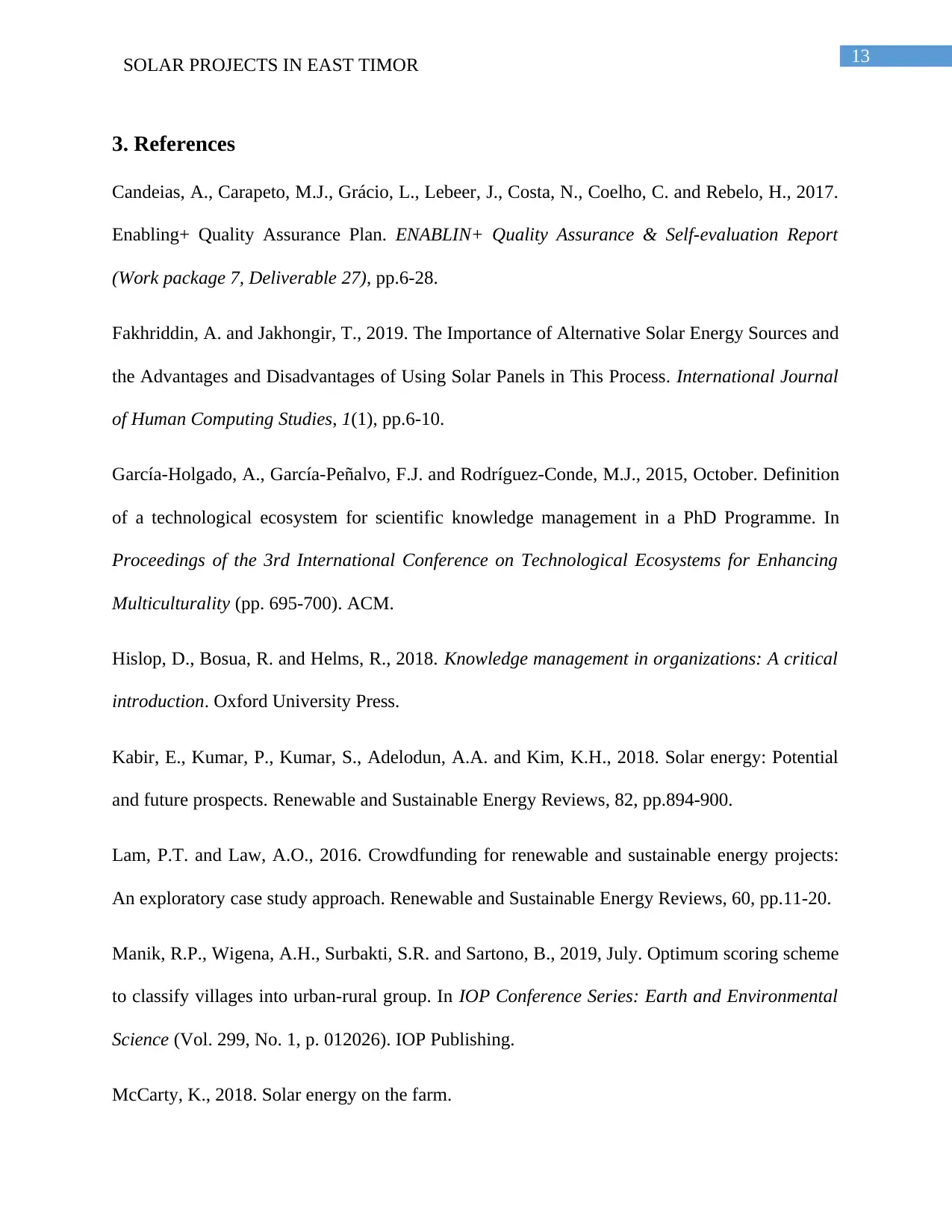
13SOLAR PROJECTS IN EAST TIMOR
3. References
Candeias, A., Carapeto, M.J., Grácio, L., Lebeer, J., Costa, N., Coelho, C. and Rebelo, H., 2017.
Enabling+ Quality Assurance Plan. ENABLIN+ Quality Assurance & Self-evaluation Report
(Work package 7, Deliverable 27), pp.6-28.
Fakhriddin, A. and Jakhongir, T., 2019. The Importance of Alternative Solar Energy Sources and
the Advantages and Disadvantages of Using Solar Panels in This Process. International Journal
of Human Computing Studies, 1(1), pp.6-10.
García-Holgado, A., García-Peñalvo, F.J. and Rodríguez-Conde, M.J., 2015, October. Definition
of a technological ecosystem for scientific knowledge management in a PhD Programme. In
Proceedings of the 3rd International Conference on Technological Ecosystems for Enhancing
Multiculturality (pp. 695-700). ACM.
Hislop, D., Bosua, R. and Helms, R., 2018. Knowledge management in organizations: A critical
introduction. Oxford University Press.
Kabir, E., Kumar, P., Kumar, S., Adelodun, A.A. and Kim, K.H., 2018. Solar energy: Potential
and future prospects. Renewable and Sustainable Energy Reviews, 82, pp.894-900.
Lam, P.T. and Law, A.O., 2016. Crowdfunding for renewable and sustainable energy projects:
An exploratory case study approach. Renewable and Sustainable Energy Reviews, 60, pp.11-20.
Manik, R.P., Wigena, A.H., Surbakti, S.R. and Sartono, B., 2019, July. Optimum scoring scheme
to classify villages into urban-rural group. In IOP Conference Series: Earth and Environmental
Science (Vol. 299, No. 1, p. 012026). IOP Publishing.
McCarty, K., 2018. Solar energy on the farm.
3. References
Candeias, A., Carapeto, M.J., Grácio, L., Lebeer, J., Costa, N., Coelho, C. and Rebelo, H., 2017.
Enabling+ Quality Assurance Plan. ENABLIN+ Quality Assurance & Self-evaluation Report
(Work package 7, Deliverable 27), pp.6-28.
Fakhriddin, A. and Jakhongir, T., 2019. The Importance of Alternative Solar Energy Sources and
the Advantages and Disadvantages of Using Solar Panels in This Process. International Journal
of Human Computing Studies, 1(1), pp.6-10.
García-Holgado, A., García-Peñalvo, F.J. and Rodríguez-Conde, M.J., 2015, October. Definition
of a technological ecosystem for scientific knowledge management in a PhD Programme. In
Proceedings of the 3rd International Conference on Technological Ecosystems for Enhancing
Multiculturality (pp. 695-700). ACM.
Hislop, D., Bosua, R. and Helms, R., 2018. Knowledge management in organizations: A critical
introduction. Oxford University Press.
Kabir, E., Kumar, P., Kumar, S., Adelodun, A.A. and Kim, K.H., 2018. Solar energy: Potential
and future prospects. Renewable and Sustainable Energy Reviews, 82, pp.894-900.
Lam, P.T. and Law, A.O., 2016. Crowdfunding for renewable and sustainable energy projects:
An exploratory case study approach. Renewable and Sustainable Energy Reviews, 60, pp.11-20.
Manik, R.P., Wigena, A.H., Surbakti, S.R. and Sartono, B., 2019, July. Optimum scoring scheme
to classify villages into urban-rural group. In IOP Conference Series: Earth and Environmental
Science (Vol. 299, No. 1, p. 012026). IOP Publishing.
McCarty, K., 2018. Solar energy on the farm.
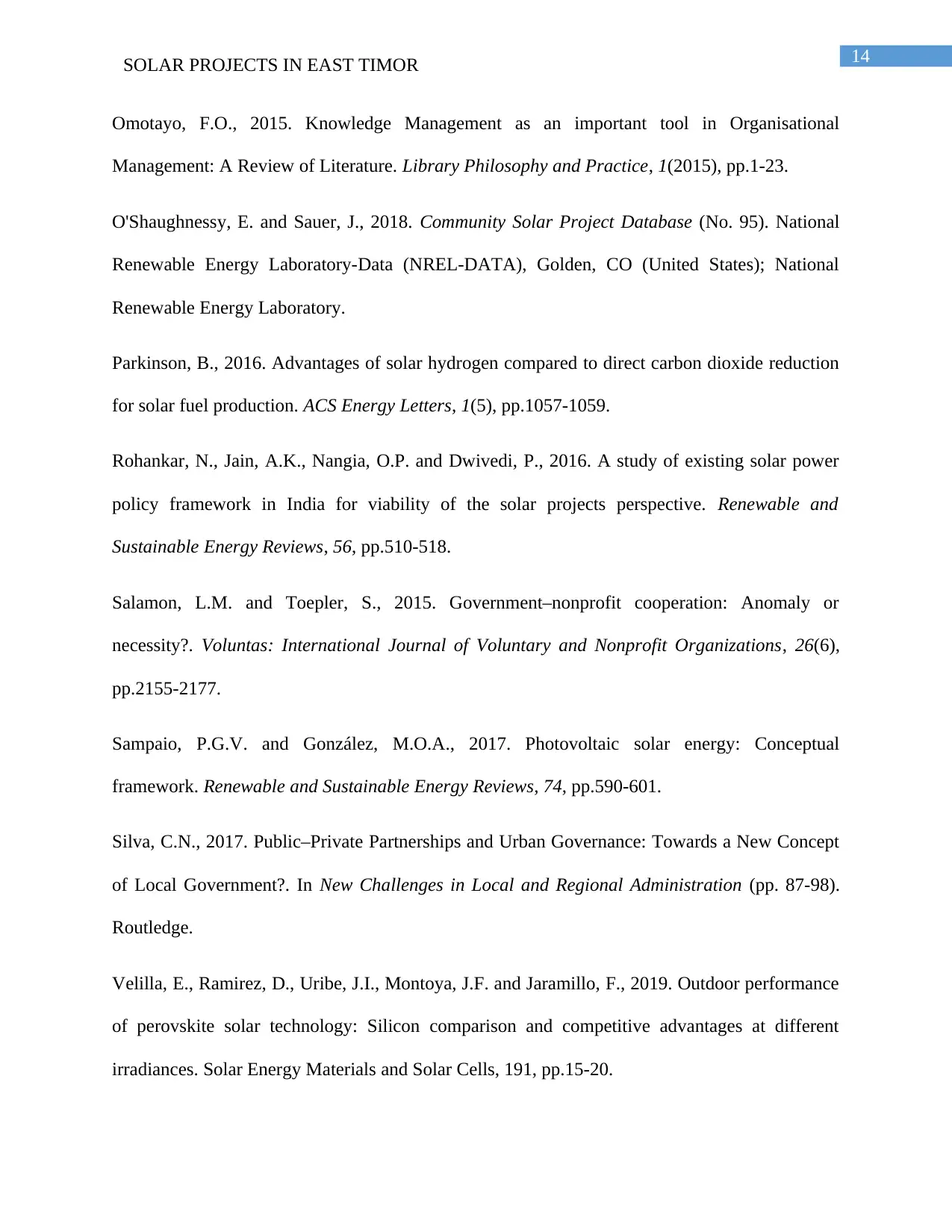
14SOLAR PROJECTS IN EAST TIMOR
Omotayo, F.O., 2015. Knowledge Management as an important tool in Organisational
Management: A Review of Literature. Library Philosophy and Practice, 1(2015), pp.1-23.
O'Shaughnessy, E. and Sauer, J., 2018. Community Solar Project Database (No. 95). National
Renewable Energy Laboratory-Data (NREL-DATA), Golden, CO (United States); National
Renewable Energy Laboratory.
Parkinson, B., 2016. Advantages of solar hydrogen compared to direct carbon dioxide reduction
for solar fuel production. ACS Energy Letters, 1(5), pp.1057-1059.
Rohankar, N., Jain, A.K., Nangia, O.P. and Dwivedi, P., 2016. A study of existing solar power
policy framework in India for viability of the solar projects perspective. Renewable and
Sustainable Energy Reviews, 56, pp.510-518.
Salamon, L.M. and Toepler, S., 2015. Government–nonprofit cooperation: Anomaly or
necessity?. Voluntas: International Journal of Voluntary and Nonprofit Organizations, 26(6),
pp.2155-2177.
Sampaio, P.G.V. and González, M.O.A., 2017. Photovoltaic solar energy: Conceptual
framework. Renewable and Sustainable Energy Reviews, 74, pp.590-601.
Silva, C.N., 2017. Public–Private Partnerships and Urban Governance: Towards a New Concept
of Local Government?. In New Challenges in Local and Regional Administration (pp. 87-98).
Routledge.
Velilla, E., Ramirez, D., Uribe, J.I., Montoya, J.F. and Jaramillo, F., 2019. Outdoor performance
of perovskite solar technology: Silicon comparison and competitive advantages at different
irradiances. Solar Energy Materials and Solar Cells, 191, pp.15-20.
Omotayo, F.O., 2015. Knowledge Management as an important tool in Organisational
Management: A Review of Literature. Library Philosophy and Practice, 1(2015), pp.1-23.
O'Shaughnessy, E. and Sauer, J., 2018. Community Solar Project Database (No. 95). National
Renewable Energy Laboratory-Data (NREL-DATA), Golden, CO (United States); National
Renewable Energy Laboratory.
Parkinson, B., 2016. Advantages of solar hydrogen compared to direct carbon dioxide reduction
for solar fuel production. ACS Energy Letters, 1(5), pp.1057-1059.
Rohankar, N., Jain, A.K., Nangia, O.P. and Dwivedi, P., 2016. A study of existing solar power
policy framework in India for viability of the solar projects perspective. Renewable and
Sustainable Energy Reviews, 56, pp.510-518.
Salamon, L.M. and Toepler, S., 2015. Government–nonprofit cooperation: Anomaly or
necessity?. Voluntas: International Journal of Voluntary and Nonprofit Organizations, 26(6),
pp.2155-2177.
Sampaio, P.G.V. and González, M.O.A., 2017. Photovoltaic solar energy: Conceptual
framework. Renewable and Sustainable Energy Reviews, 74, pp.590-601.
Silva, C.N., 2017. Public–Private Partnerships and Urban Governance: Towards a New Concept
of Local Government?. In New Challenges in Local and Regional Administration (pp. 87-98).
Routledge.
Velilla, E., Ramirez, D., Uribe, J.I., Montoya, J.F. and Jaramillo, F., 2019. Outdoor performance
of perovskite solar technology: Silicon comparison and competitive advantages at different
irradiances. Solar Energy Materials and Solar Cells, 191, pp.15-20.

15SOLAR PROJECTS IN EAST TIMOR
1 out of 16
Related Documents
Your All-in-One AI-Powered Toolkit for Academic Success.
+13062052269
info@desklib.com
Available 24*7 on WhatsApp / Email
![[object Object]](/_next/static/media/star-bottom.7253800d.svg)
Unlock your academic potential
© 2024 | Zucol Services PVT LTD | All rights reserved.





